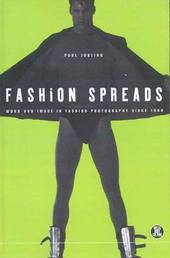
|
Fashion Spreads: Word and Image in Fashion Photography Since 1980
Paperback / softback
Main Details
| Title |
Fashion Spreads: Word and Image in Fashion Photography Since 1980
|
| Authors and Contributors |
By (author) Paul Jobling
|
| Series | Dress, Body, Culture |
|---|
| Series part Volume No. |
v. 8
|
| Physical Properties |
| Format:Paperback / softback | | Pages:288 | | Dimensions(mm): Height 234,Width 156 |
|
| Category/Genre | Photographs: collections |
|---|
| ISBN/Barcode |
9781859732281
|
| Classifications | Dewey:779.9391009046 |
|---|
| Audience | |
|---|
| Illustrations |
1, black & white illustrations
|
|
Publishing Details |
| Publisher |
Bloomsbury Publishing PLC
|
| Imprint |
Berg Publishers
|
| Publication Date |
1 May 1999 |
| Publication Country |
United Kingdom
|
Description
Doubly tainted by its associations with consumerism and the 'frivolous' world of couture, fashion photography has long been ignored as a serious site for academic study. Yet both the body and dress have proved keenly revealing of gender, race and sexual politics. Further, fashion photography has been transformed by aesthetic concerns, sexual politics and the pleasure of spectatorship - all of which suggest that its iconography represents a rich source for the analysis of how identity is constructed. Exploring representations of the feminine and the masculine body - from super-vamp to super-waif, from buffalo boy to new man - this book considers the social, economic and aesthetic factors that have been instrumental in forging an identity for fashion photography since 1980. Drawing extensively on fashion spreads from Vogue, The Face and Arena, the author takes as his starting point Barthes' axiom that the magazine is 'a machine for making Fashion'. He explores how meaning is constructed in word and image, but he refutes Barthes' claim that the fashion system is a vacuous form of signification. In evaluating the ostensible paradox between sexual objectification and spectatorship, the author also looks at what the depiction of both male and female bodies in fashion spreads reveals about power, knowledge and pleasure. How does the iconography of fashion gratify our desires? Who are these images for - men and women? men or women? Does fashion photography invent role models, or simply satisfy nascent cultural values of beauty and sexual attraction? Why is fashion photography considered a form of 'soft porn' for the delectation of men when women are by far the largest consumers of fashion periodicals? How do the investments of different producers and spectators - male and female, gay and straight, white and non-white - affect the fashion image? In answering these questions and many more, this book represents a significant contribution to the following areas: photography; fashion and dress; cultural studies; sex, race and gender studies; art and design history; media studies; and sociology.
Author Biography
Paul Jobling is at Winchester School of Art.
|